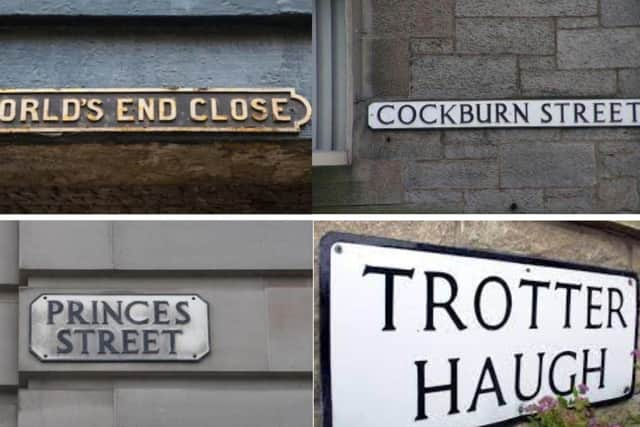23 of Edinburgh's most unusual street names and the surprising history behind them
and live on Freeview channel 276
Home to literary legends like Robert Louis Stevenson and Dame Muriel Spark, it’s hardly surprising that many of Edinburgh's street names are playful and poetic.
Here, we take a look at the curious names of some of Auld Reekie's best known streets.
Advertisement
Hide AdAdvertisement
Hide AdCroft An Righ: The name of this narrow Edinburgh thoroughfare translates from Scottish Gaelic as ‘Seat of the King’ or ‘King’s Croft’, and came from its proximity to Holyrood Palace.


Brodie’s Close: This Old Town close is often presumed to be named after notorious criminal Deacon Brodie, who was hanged in 1788.
Fleshmarket Close: Fleshmarket Close is a 2004 crime novel by Inspector Rebus author Ian Rankin, and is named after a real close in Edinburgh between the High Street and Market Street. It was named after the meat market which was situated therem which led to a slaughterhouse at the side of the Nor' Loch.
Cuddy Lane: Cuddy means ‘donkey’ or ‘stupid’ in the Scottish dialect. According to late Edinburgh author Charles Boog Watson, this Morningside street is named after its residents – but he doesn’t specify whether this is in reference to the animals or the locals.
Advertisement
Hide AdAdvertisement
Hide AdPotterrow: No, it’s got nothing to do with Harry Potter. Instead, it is but named after the industry of its former residents – you guessed it, potters.
World’s End Close: This final close before High Street becomes the Canongate. It was named way back when some Edinburgh’s poorest residents couldn’t even afford to leave the city walls – the street was the figurative end of their world.
Fair-a-far: The curiously titled Cramond street is named after a local farm. Sadly, the origins of the farm’s name have sadly been forgotten over time.
Pleasance: Many moons ago, this Fringe hotspot was referred to as ‘The Pleasant’. The unusual name was taken from a convent, named after St Mary of Placentia.
Advertisement
Hide AdAdvertisement
Hide AdDumbiedykes Road: Off Holyrood Road, this mainly residential street was named after a school for the deaf and dumb which once sat on the boundaries of Holyrood Park.
Sciennes Road: This commonly mispronounced thoroughfare takes its name from the Convent of St Catherine of Siena. This is spelled ‘Sienne’ in French, which was the court language of Scotland in the 1500s.
Cockburn Street: Named after notable lawyer, judge and writer Sir Henry Cockburn, who took a keen interest in preserving the city’s architectural heritage.
Bellenden Gardens: Takes its name from its shape, according to local legend.
Advertisement
Hide AdAdvertisement
Hide AdCadzow Place: In the Meadowbank area, the inspiration for Cadzow Place came from the Lanarkshire village of Cadzow, which was the setting for Sir Walter Scott’s ballad of Cadzow Castle.
Aitchison’s Place: This street in the seaside resort of Portobello was named after a 19th-century sweetmaker, noted in the history books just as Mr Aitchison.
Princes Street: The busy shopping street was originally intended to be named after the city’s patron saint, Giles. However, according to Watson, King George III “in his stupidity” associated the name with a London slum “and he would have none of it”. The name was therefore changed to honour George’s sons, the Royal Princes.
Picardy Place: Named after the Protestants who sought refuge in Edinburgh from the French region of Picardy
Advertisement
Hide AdAdvertisement
Hide AdSalamander Street: This Leith street was once the home of fiery and toxic glass and chemical works. According to Charles Boog Watson, the street takes its name from the salamander lizard (which folklore says can survive the flames of a fire) as this is the only creature that could live in such conditions.
Stanley Street: Likely named after American journalist Henry Morton Stanley, who explored Africa in the 19th century and allegedly ‘discovered’ David Livingstone, who had disappeared on the continent.
Quality Street: A Davidson’s Mains street where the houses were allegedly of better quality than neighbouring houses.
Candlemaker Row: Unsurprisingly, the name is taken from the industry which once operated here. Candlemaker Row was home to the Hall of the Incorporation of Candlemakers, among other waxy establishments.
Advertisement
Hide AdAdvertisement
Hide AdFountainbridge: Not named for its proximity to the Union Canal, but rather the Dalry Burn, which ran from the Borough Loch in the Meadows over towards Coltbridge.
Alan Breck Gardens: This Clermiston street is named after a character from Robert Louis Stevenson’s Kidnapped. In the novel, David Balfour climbs Clermiston Hill before spying his Uncle Ebenezer’s house.
Danube Street: Many will be familiar with the river Danube, which runs through Budapest and Vienna. Its permanent link to Edinburgh is likely due to the European connection of Hanoverian Kings George II, III and IV.
Comment Guidelines
National World encourages reader discussion on our stories. User feedback, insights and back-and-forth exchanges add a rich layer of context to reporting. Please review our Community Guidelines before commenting.
